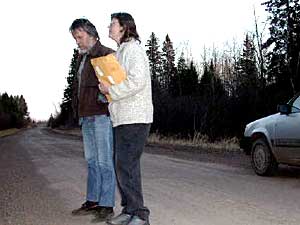|
Audio
Photos
More from MPR
Resources
Your Voice
|
Frog music
May 6, 2003
 |
| Matt Christianson and Regina Kijak listen for frogs on a lonely road outside Two Harbors. Hundreds of volunteers are helping the DNR with its frog and toad calling survey. (MPR Photo/Chris Julin) |
Two Harbors, Minn. — The sun is going down as Regina Kijak and Matt Christianson drive down a bumpy dirt road outside the town of Two Harbors.
"What do we look for now?" asks Regina, looking at a map.
"Drummond," says Matt, naming a local road.
Once in a while they pass a dirt crossroad. Now and then they see a house in a clearing. But mostly what they see are spruce trees.
 | |||
Matt and Regina got their map from the DNR. It came with a list of 10 places to stop along the road. Their first stop is several miles inland from Lake Superior.
It's still twilight as they climb out of their station wagon. The ditch on either side of the road is a mucky soup of water and brown vegetation. Regina takes notes. It's 7:45 p.m., there is no wind, and the temperature is 40 degrees.
That's pretty chilly for frog singing, but they stand in the road listening.
After several minutes of northwoods silence, the quiet breaks. Two geese fly low overhead, filling the forest with honks like the horn on a Buick. A white-throated sparrow pipes its gentler spring call. And off in the distance there's a faint gurgle of what sounds like a solitary wood frog.
Minnesota is home to 14 species of frogs and toads. This is mating season, and each species has a distinctive call. So the survey is a simple, low-tech way to get a sense of where frogs live, and a rough idea of how many there are. Frog populations are a good indicator of how healthy the water is.
This is the first time Regina and Matt have volunteered for the frog and toad survey, so Regina's been studying frog calls. Different species call at different times. In early spring, the DNR asks volunteers to concentrate on just four species of frogs.
 | |||
"They do send you a tape that you can listen to," Regina says, "but then after that, you just use your ears."
Matt says he didn't listen to the tape.
"She did," he says, smiling at Regina. "I didn't. But we talked, and she's told me what they sound like by mimicking their sounds. She does a good job at that."
Regina nods and lists the four frogs they're listening for on this trip -- the spring peeper, the wood frog, the northern leopard frog, and the chorus frog.
"The chorus frog sounds like someone running their finger along a plastic comb," Regina says. "The wood frog sounds like ducks. The spring peeper just sounds like birds peeping. Peep. Peep. Peep. In one-second intervals. And then the northern leopard frog sounds like a creaking door, or a very long, drawn-out snore."
Regina writes down that they heard a few scattered wood frogs here at the first stop. Then she and Matt get back in the car.
It's about a mile to the next stop. Regina double checks the DNR's description of the next stop.
 | |||
"All right, this is it," she says as they pull to a stop at the intersection of two dirt roads. "Wooded and temporary pools, by gully."
They climb back out of the car.
This time the frogs are singing. The spring peepers' songs are so steady they almost blend into one steady tone -- almost like a referee's whistle.
"Quite a grouping here," Matt whispers.
"Yeah, it is a good group," Regina whispers back. "I'm going to put number three."
Regina writes down a number for each species. The peepers get a three, meaning a steady chorus of frog song. Wood frogs get a one, meaning occasional, individual calls. Regina will make the same kind of notes at each of the 10 stops on the route.
This spring, about 300 volunteers have done the same thing all over Minnesota. They'll all be back on the road again in late May, and once more at the end of June.
The DNR collects the data in Minnesota. Then the U.S. Geological Survey collects numbers from around the country.
This is only the eighth year of the survey, so it's too early to draw conclusions, but biologists at the DNR say the information will be helpful when there's more of it. They say the frog and toad-calling survey gives regular folks a chance to take part in real science.
|
News Headlines
|
Related Subjects
|
